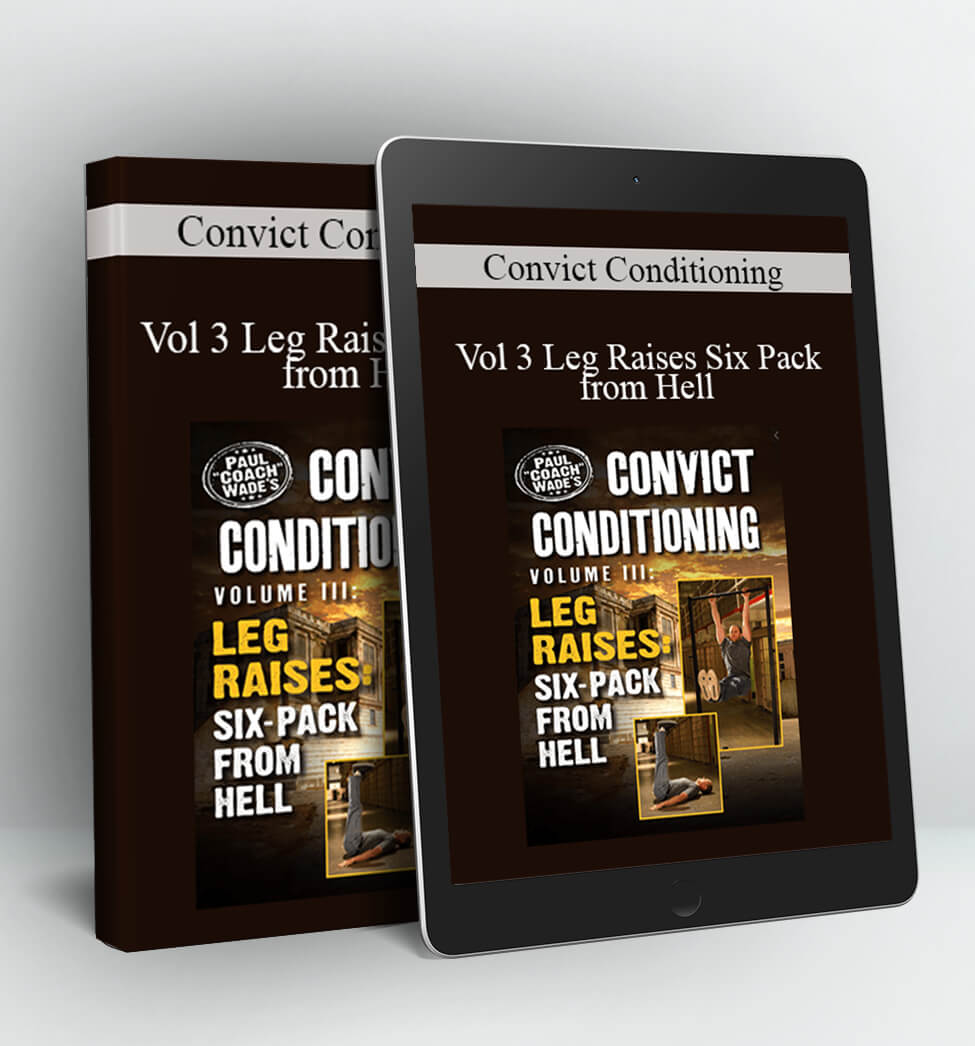
Vol 5 One-Arm Pullup Series – Convict Conditioning
Paul Wade’s Convict Conditioning system represents the ultimate distillation of hardcore prison bodyweight training’s most powerful methods. What works was kept. What didn’t, was slashed away. When your life is on the line, you’re not going to mess with less than the absolute best. Many of these older, very potent solitary training systems have been on the verge of dying, as convicts begin to gain access to weights, and modern “bodybuilding thinking” floods into the prisons. Thanks to Paul Wade, these ultimate strength survival secrets have been saved for posterity. And for you…
Filmed entirely—and so appropriately—on “The Rock”, Wade’s Convict Conditioning Volume 5, Maximum Strength: The One-Arm Pullup Series explodes out of the cellblock to teach you in absolute detail how to progress from the relative ease of a Vertical Pull—to the stunning, “1-in-1,000” achievement of the One-Arm Pullup. Ten progressive steps guide you to inevitable mastery of this ultimate exercise for supreme upper body survival strength.
This home-study course in ultimate survival strength comes replete with bonus material not available in Paul Wade’s original Convict Conditioning book—and numerous key training tips that refine and expand on the original program.
Whatever you are looking for from your pullups—be it agile survival strength, arms of steel, a massive upper back with flaring lats, Popeye Biceps or gape-inducing abs—it’s yours for the progressive taking with Convict Conditioning Volume 5, Maximum Strength: The One-Arm Pullup Series.
Your Roadmap to Physical Glory—One Step At a Time…
In Paul Wade’s Convict Conditioning system, no matter what kind of movement you’re working on, you focus on a chain of ten progressive exercises. When you master one exercise, you move on to the next, and so on. Because the later exercises build on the earlier ones, they are sometimes called the “ten steps”. When you reach the tenth exercise, you will be just about as strong as it’s possible for a human being to be in that movement. For this reason, the tenth exercise in any chain is called the “Master Step”. How this all works will be crystal clear if you’ve picked up a copy of the Convict Conditioning bodyweight book.
Why it should be downright illegal—and a punishable offense—not to practice pullups with furious intensity,
for as long as you live…
If you go into a gym these days, you’ll see guys and girls doing lots of different back movements. Bent-over rows, cable rows, pulldowns, one-arm rows, as well as working on any number of flashy new back training machines available. But the most productive and useful upper back exercise in the world is usually the one most trainees avoid. That exercise is the pullup. You could write a book on why the pullup is so effective. We don’t have time for that, but right now we are going to give you four damn good reasons why the pullup should be an absolutely mandatory part of your training:
Number one:Pullups are the number-one upper back builder. This is hard to dispute. As well as working virtually all the upper back muscles, pullups really effectively target the latissimus dorsi, the “lats”, the biggest muscles of the upper back. Our distant ancestors evolved pulling their own weight up through the trees, and that anatomical heritage is still there, lying dormant in all our bodies. Pullups harness this genetic advantage in the quickest possible way. Some guys get big lats almost overnight from this exercise!
Number two:Pullups are functional. This is an important part of prison training. It teaches you to move. Pullups are a training in self-movement. A fat, out-of-shape bodybuilder might be able to deadlift five-hundred pounds, but can he get up and over a high wall? A strong, agile pullup-trained athlete can do this in half a second.
Number three:Pullups are the best biceps builder in the world. Look at the guns on a gymnast if you don’t believe me. Curls only work the biceps through one joint, the elbow joint, and this limits their power. Pullups work the biceps through both joints, the shoulder and the elbow. This makes them the most effective technique possible.
Number four:Pullups are very safe. Most acute injuries in the gym occur to the spine and particularly the lower back area. A lot of these come from back training, and bending over while holding weights—deadlifts, rows and cleans can cause a lot of injuries this way. But because your feet are off the ground during harder pullups, there’s minimal force going through your spine. Your chances of a lower back injury during pullups are virtually zilch.
If you want more information on pullup theory and anatomy, refer to the Convict Conditioning book, chapter seven.
What every athlete needs to know
about how to get really strong with pull-ups…
So if the pullup is so great, why is it that so many trainees are skipping this movement in their routine? Well, there are two reasons. First, a lot of guys—either heavy people or beginners—look at classic pullups and think they’re just too tough. These people may not yet be able to pull their own bodyweight. So they get intimidated by this exercise. Coming from the opposite angle, many advanced athletes see the pullup as too easy; they might be able to easily pull their weight with two hands, and turn to barbell exercises to provide more weight.
Both these attitudes show a lack of understanding of progressive calisthenics. When these trainees think of a “pullups”, they picture the regular two-handed full pullup. In reality, there is more than just one type of pullup.
The “pullup” isn’t just an exercise, it’s a whole family of movements. Some of these movements are real easy, and could be done by almost anybody, even total beginners. Some of them are incredibly hard—much harder than the regular pullup—and can only be performed by a handful of the strongest men on the planet.
This is where Convict Conditioning comes in. The Convict Conditioning system takes ten of the best pullup-type movements, and puts these techniques in order of difficulty. You start the system at the bottom, with a real easy exercise. Once you master that technique, you move to the next exercise, which is just a little harder, and so on.
These exercises have been broken up into a set of stages, which is sometimes called the “ten steps”. This is a key feature of the Convict Conditioning system. Without following some kind of structured, progressive approach, it would be impossible for even the most naturally powerful athlete to achieve incredible feats like assisted pullups and one-arm pullups.
Like all big achievements, you need to break these seemingly impossible stunts into chunks.
But don’t get led astray by the idea of the “ten steps”. Each exercise, each “step” is just a stage. There are actually many more than just ten pullup exercises in the system, and you can use as many as you need to progress.
For example, in one step you do pullups with your hands about shoulder-width apart. On the next step, to make things harder, you bring your hands close, right next to each other. These form two steps in the series, but in reality if you wanted you could bring your hands in an inch each time you train—so you’ve turned two exercises, two hand positions, into more than a dozen.
Likewise, on assisted pullups you help yourself up by pulling on a towel—but how and where you grip the towel makes a big difference to the difficulty. So, if you’re smart, one exercise can become several exercises, by applying a subtle change. After we show you each exercise, we’ll give you an idea of how to discover these “hidden steps”.
There’s a whole lifetime of great training and exercises in here!
Access Download Vol 5 One-Arm Pullup Series – Convict Conditioning right now!
Delivery Method:
After your purchase, you’ll get access to the downloads page. Here, you can download all the files associated with your order.
Downloads are available once your payment is confirmed, we’ll also send you a download notification email separate from any transaction notification emails you receive from Coursedownloads.







